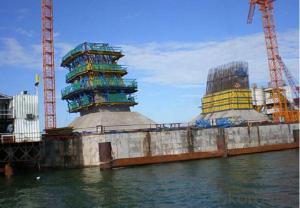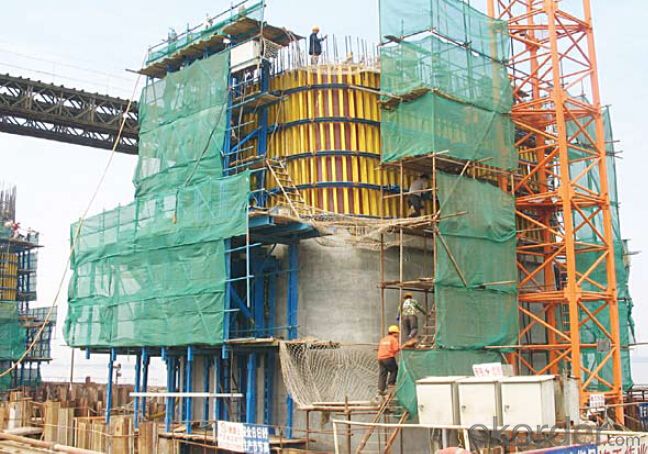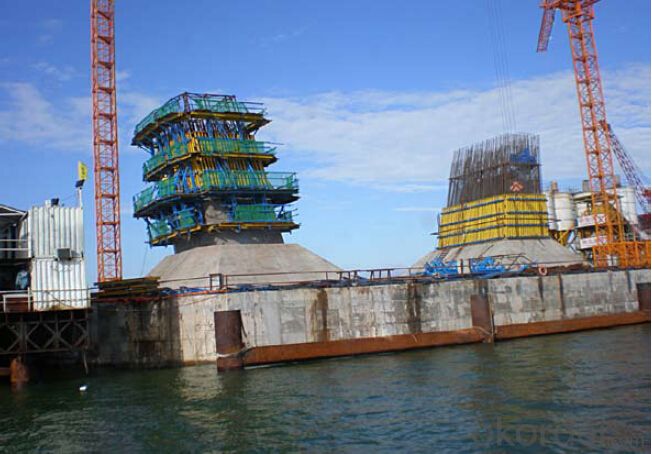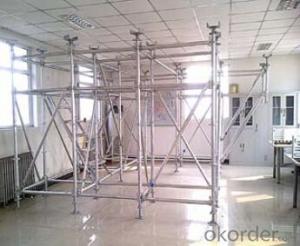Auto-Climbing bracket ACB100 for formwork and scaffolding system
- Loading Port:
- Tianjin
- Payment Terms:
- TT OR LC
- Min Order Qty:
- 50 m²
- Supply Capability:
- 1000 m²/month
OKorder Service Pledge
OKorder Financial Service
You Might Also Like
Auto-climbing Bracket ACB100 & ACB50
The power of the auto-climbing formwork is the hydraulic system, which includes the oil cylinder
and two commutators. The commutators can control the climbing of climbing rail and the bracket.
The steel rail and the bracket can inter-climbing, so the whole system will climb up steadily.
Cranes are not needed during the construction. It’s easy to operate, highly efficient and safe. It’s
the best choice for the construction of high buildings and bridges.
There are mainly two types of standard auto-climbing brackets, ACB-50 and ACB-100, the figure
means the push power of cylinder with unit of KN.
Characteristics:
◆ Perfect load bearing anchor system
Anchor system is the most important supporting part. The system is made of five parts shown
below. Thereinto, tensile bolt, V-climbing cone and washer can be taken out for reusing after the
concrete pouring finished.There are two kinds of anchor systems,A & B. A is matched with single
anchor shoe and B is matched with double anchor shoe.
◆ Crane-independent
Crane-independent forming, striking and climbing speeds up the work procedures on the
construction site and also makes them independent of each other. This means the planned
sequences can be maintained along with guaranteeing high productivity levels. The crane can
therefore be used for other tasks.
Hydraulic system is mainly made of two commutators,
oil cylinder and power distribution system.The
commutators can control the climbing of climbing rail
and bracket.
◆ High bearing capacity and safe
The stable working platforms are able to carry large loads, e.g. the storage of reinforcing steel
for the next climbing section. Generously-sized working platforms, the well thought-out design for
handling very high wind loads and the patented control function of the climbing mechanism are
some of the special details contained within the comprehensive safety concept.
◆ Platforms adjusted to suit the angle of inclination
The horizontal working areas thus created provide safe and comfortable conditions for
reinforcement work, shuttering and striking, concreting and finishing.
◆ The ACB formwork system can climb not only vertically but also slantways, the largest angle is
18 degrees.
◆ The system can climb up wholly or separately. The climbing process is steady, synchronous
and safe.
◆ The bracket will not fall to the ground until the construction is finished, the field will be saved
and the impacting breakage will be reduced (especially the panel).
◆ The system will furnish omnidirectional platform, the construction organizations don’t need to
set up additional operation platform.
◆ The error of structure construction is small and easy to correct.
◆ The climbing speed is fast, the construction course will be quickened.
◆ The formwork can climb itself and cleaning work can be done in the same situs , the used times
of tower crane will be greatly reduced.
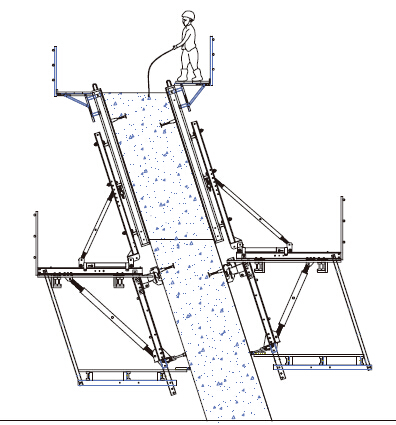
- Q: How is steel formwork supported during concrete pouring?
- During the pouring of concrete, steel formwork relies on a support system consisting of props, beams, and scaffolding. Props, which are vertical supports, are strategically positioned beneath the steel formwork to maintain stability and prevent any sagging or collapsing under the weight of the wet concrete. These props can be adjusted to achieve precise positioning and leveling of the formwork. In addition to props, horizontal beams are employed to provide additional support for the steel formwork. These beams are typically placed at regular intervals and connected to the props, creating a robust framework capable of withstanding the pressure exerted by the concrete. The beams also aid in distributing the load evenly across the formwork, ensuring its balance and security. Scaffolding is another essential component in supporting the steel formwork during concrete pouring. It is erected around the formwork to provide a secure working platform for workers to access and maneuver the formwork. Scaffolding also facilitates the installation and removal of the formwork, streamlining the construction process. In summary, the combination of props, beams, and scaffolding plays a crucial role in supporting steel formwork during concrete pouring. This support system ensures the stability of the formwork, allowing for accurate pouring and curing of the concrete, resulting in a structurally sound and long-lasting building.
- Q: Can steel formwork be easily transported to different job sites?
- Yes, steel formwork can be easily transported to different job sites. Steel formwork is known for its durability and strength, making it suitable for repeated use and easy transportation. It can be disassembled and reassembled without losing its structural integrity, allowing it to be easily transported to different locations. Additionally, steel formwork is lightweight compared to other types of formwork, making it easier to handle and transport using regular construction machinery or vehicles. Its versatility and transportability make steel formwork a popular choice for construction projects that require frequent movement between job sites.
- Q: Are there different sizes of steel formwork available?
- Indeed, a variety of sizes of steel formwork can be found. Steel formwork, a versatile construction material, sees extensive use in a multitude of building endeavors. Its inherent strength, durability, and stability render it well-suited for diverse applications. Customization of steel formwork to match specific project demands facilitates the creation of various shapes and structures, enabling flexibility. Moreover, the utilization of steel formwork facilitates efficient construction procedures, owing to its effortless assembly and disassembly, rendering it suitable for projects of all scales, be they small or large.
- Q: Can steel formwork be used for both reinforced and non-reinforced concrete structures?
- Yes, steel formwork can be used for both reinforced and non-reinforced concrete structures. Steel formwork is a versatile and durable option that can withstand the pressure exerted by the concrete during the casting process. It can be easily assembled and disassembled, making it suitable for various types of construction projects. Whether it is a reinforced structure that requires additional support for the reinforcement bars or a non-reinforced structure that only requires a temporary mold, steel formwork can be used effectively in both cases. Its strength and stability allow for the creation of precise shapes and dimensions, ensuring the desired outcome for any concrete structure.
- Q: How does steel formwork improve construction site safety?
- Construction site safety is improved in several ways through the use of steel formwork. Firstly, the durability and strength of steel formwork make it capable of withstanding heavy loads and pressures, reducing the likelihood of accidents or collapses during construction. This increased stability ensures the safety of workers on-site. In addition, steel formwork is designed to be modular and easily assembled, which reduces the time and effort required for construction. This simplifies the process and minimizes workers' exposure to hazardous conditions, such as working at heights or in confined spaces. Furthermore, steel formwork is highly fire-resistant, which is a critical safety consideration on construction sites. In the event of a fire, steel formwork can withstand high temperatures and maintain its structural integrity, providing a safe escape route for workers and reducing the risk of injuries or fatalities. Moreover, steel formwork offers a smooth and level surface, which enhances the overall safety of the construction site. This eliminates any uneven or unstable surfaces that could potentially cause accidents, such as tripping or falling. Additionally, steel formwork is reusable and can be easily dismantled and reassembled for multiple construction projects. This not only saves costs but also reduces waste and minimizes the environmental impact of construction activities. By promoting sustainable practices, steel formwork contributes to creating a safer and healthier working environment for construction workers. In conclusion, steel formwork plays a crucial role in enhancing construction site safety by providing stability, fire resistance, efficient assembly, and a smooth surface. It helps to mitigate risks and hazards, ensuring the well-being of workers and improving overall construction site safety.
- Q: How does steel formwork handle reinforcement placement?
- Steel formwork is a versatile and popular option in construction because of its strength, durability, and efficient reinforcement placement. When it comes to handling reinforcement placement, steel formwork offers multiple advantages. To begin with, steel formwork provides a sturdy structure that can withstand the weight and pressure of reinforcement bars. This ensures that the bars remain in their desired position during the concrete pouring process, eliminating the risk of deformation or displacement. Consequently, the structural integrity of the final concrete structure is ensured. Moreover, steel formwork comes with pre-determined holes and slots, enabling precise placement of reinforcement bars. These pre-designed openings allow for quick and accurate installation of the bars, reducing the time and effort required for reinforcement placement. Additionally, steel formwork offers the flexibility to adjust the position of the reinforcement bars if necessary, ensuring optimal placement for specific project requirements. Furthermore, steel formwork provides easy access to the reinforcement bars during concrete pouring. Removable panels or openings can be incorporated into the formwork design, allowing construction workers to monitor and adjust the placement of reinforcement bars as needed. This accessibility guarantees proper positioning of the reinforcement, preventing any potential weak areas or structural deficiencies in the concrete structure. Lastly, steel formwork allows for efficient integration of various reinforcement elements, such as steel mesh, rebar cages, or post-tensioning systems. The formwork system can be designed to accommodate these different reinforcement methods, ensuring compatibility and ease of installation. This flexibility in reinforcement placement is particularly advantageous for complex or intricate concrete structures that require specific reinforcement configurations. In conclusion, steel formwork is well-suited to handle reinforcement placement efficiently. Its strength, rigidity, and pre-designed openings enable accurate and secure positioning of reinforcement bars. The accessibility and adaptability of steel formwork further enhance its capability to handle various reinforcement elements, ensuring the integrity and strength of the final concrete structure.
- Q: What are the different types of tie systems used in steel formwork?
- There are several different types of tie systems that are commonly used in steel formwork in construction projects. These tie systems are designed to provide stability and support to the formwork during the concrete pouring process. Some of the main types of tie systems used in steel formwork include: 1. Tie rods and wing nuts: This is the most commonly used tie system in steel formwork. It consists of steel rods that are inserted through the formwork panels and secured with wing nuts. This system allows for quick and easy assembly and disassembly of the formwork. 2. Shear connectors: Shear connectors are used in situations where there is a need to transfer shear forces between the formwork and the concrete. These connectors typically consist of steel bars that are embedded in the concrete and connected to the formwork. 3. Steel form ties: Steel form ties are used to hold the formwork panels together and maintain the desired shape and alignment during concrete pouring. These ties are typically made of steel and are available in various lengths and sizes to accommodate different formwork requirements. 4. Adjustable formwork systems: These systems are designed to provide flexibility in adjusting the formwork to different shapes and sizes. They often incorporate adjustable brackets and clamps that allow for easy and precise alignment of the formwork panels. 5. Stay-in-place formwork systems: Stay-in-place formwork systems are designed to remain in place after the concrete has cured, eliminating the need for formwork removal. These systems are typically used in applications where the formwork is intended to become a permanent part of the structure, such as in bridges or tunnels. Overall, the choice of tie system in steel formwork will depend on factors such as the project requirements, structural design, and the specific conditions of the construction site. It is important to select a tie system that can provide the necessary stability and support for the formwork, while also considering factors such as ease of installation, reusability, and cost-effectiveness.
- Q: Are there any specific considerations for using steel formwork in areas with limited access?
- There are several factors to consider when using steel formwork in areas with limited access. Firstly, it is important to take into account the size and weight of the steel formwork components. They may need to be transported through narrow passages or lifted to higher levels using cranes or other lifting equipment. This requires careful planning and coordination to ensure the safe maneuvering of the formwork into the desired location. In addition, assembling and disassembling steel formwork in areas with limited access can be more difficult compared to areas with ample space. The restricted space may hinder the movement of workers and equipment, making the installation and dismantling of the formwork more time-consuming and labor-intensive. Furthermore, the limited access may also restrict the use of certain construction equipment or machinery that is typically used with steel formwork. This can affect the efficiency and productivity of the construction process, as alternative methods or equipment may need to be used. Moreover, the logistics of delivering and storing steel formwork in areas with limited access need to be carefully planned. Specialized vehicles or alternative routes may be necessary to overcome the constraints of narrow roads or tight corners. Adequate storage space for the formwork components should also be considered to ensure they can be safely stored without obstructing the limited access areas. Lastly, safety is paramount when working with steel formwork in areas with limited access. The restricted space increases the risk of accidents or injuries, so it is crucial to implement proper safety measures such as providing sufficient lighting, clear signage, and appropriate personal protective equipment. In conclusion, using steel formwork in areas with limited access requires thorough planning, careful coordination, and adherence to safety protocols. By considering these factors, construction projects can overcome the challenges posed by restricted access and successfully utilize steel formwork for efficient and effective construction.
- Q: How does steel formwork compare to plywood formwork?
- Steel formwork and plywood formwork are commonly used materials in construction for creating molds or frameworks for concrete structures. Both materials have their pros and cons, but steel formwork generally has several advantages over plywood formwork. One of the main benefits of steel formwork is its durability and longevity. Steel is a strong material that can handle heavy loads and repeated use without losing its structural integrity. Unlike plywood, which can warp, expand, or deteriorate over time due to moisture, steel formwork can be used for multiple projects, making it a cost-effective choice in the long term. Another advantage of steel formwork is its precision and accuracy. Steel molds can be manufactured with great precision, ensuring that the final concrete structure meets all the required specifications. This is especially important for complex or intricate designs where accuracy is crucial. Plywood formwork may not provide the same level of precision due to its flexibility and susceptibility to warping. Steel formwork also offers improved safety features. Due to its rigidity and strength, steel molds provide a stable and secure working platform for construction workers. This reduces the risk of accidents and injuries during the concrete pouring and curing process. Plywood formwork, although commonly used, may have a higher risk of collapse or failure, especially in large-scale projects or areas with adverse weather conditions. Furthermore, steel formwork can be easily assembled and disassembled, allowing for efficient and quick construction processes. Steel molds are usually prefabricated and can be easily transported to the construction site, minimizing the need for on-site carpentry work. Plywood formwork, on the other hand, requires more time and effort to set up and dismantle, resulting in longer construction timelines and increased labor costs. However, it is important to note that steel formwork is generally more expensive upfront compared to plywood formwork. The initial cost of steel molds may be higher, but their long-term value and durability make them a worthwhile investment, especially for large construction projects or projects that require repetitive use of formwork. In conclusion, while both steel formwork and plywood formwork have their advantages, steel formwork offers several benefits in terms of durability, precision, safety, and efficiency. Despite the higher initial cost, steel formwork is a reliable and cost-effective choice for construction projects, particularly those that require high-quality finishes and complex designs.
- Q: What are the common maintenance practices for steel formwork?
- To ensure the steel formwork's optimal performance, various maintenance practices should be followed. These include regular cleaning and inspection, lubrication of movable parts, repair of any damage or wear, and appropriate storage when not in use. To maintain cleanliness, it is crucial to remove any concrete residue, dirt, or debris that may accumulate on the formwork. This can be achieved by using water, a mild detergent, and a stiff brush. Caution should be exercised to avoid abrasive materials or chemicals that may harm the steel. It is necessary to conduct routine inspections to identify signs of wear, damage, or corrosion. This should be done both before and after each use of the formwork. Any cracks, deformations, or loose parts should be promptly repaired or replaced to ensure the formwork remains safe and functional. Lubricating moving parts, such as hinges, locks, and adjustable components, is of utmost importance to guarantee smooth operation. Applying a suitable lubricant to these parts helps prevent rust, corrosion, and sticking. This practice helps maintain the formwork's functionality and ease of use. Repairing any damage or wear is vital to uphold the structural integrity of the formwork. Swift action should be taken to repair any cracks or deformations using appropriate methods like welding or reinforcing. Damaged parts must be replaced with new ones to uphold the formwork's strength and stability. Proper storage is essential to prolong the lifespan of steel formwork and prevent damage. It should be stored in a dry and well-ventilated area to avoid corrosion. Additionally, formwork should be stacked or stored in a manner that prevents distortion or bending of the steel components. Furthermore, protecting the formwork from moisture and excessive heat is crucial to avoid potential damage. By adhering to these common maintenance practices, the steel formwork can be preserved in excellent condition, ensuring its durability and reliability for future use.
Send your message to us
Auto-Climbing bracket ACB100 for formwork and scaffolding system
- Loading Port:
- Tianjin
- Payment Terms:
- TT OR LC
- Min Order Qty:
- 50 m²
- Supply Capability:
- 1000 m²/month
OKorder Service Pledge
OKorder Financial Service
Similar products
Hot products
Hot Searches

